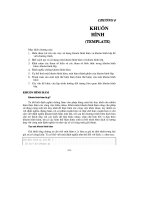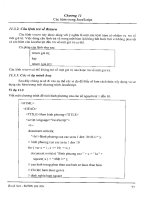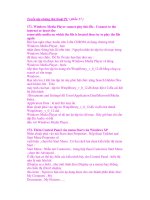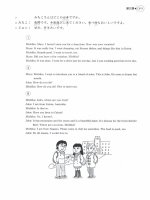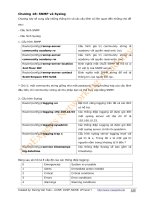Ajax in Oracle JDeveloper phần 8 potx
Bạn đang xem bản rút gọn của tài liệu. Xem và tải ngay bản đầy đủ của tài liệu tại đây (1.64 MB, 23 trang )
152 7 Ajax with JSF-Ajax4jsf
return inputText5;
}
public void setOutputLabel6(HtmlOutputLabel
outputLabel6) {
this.outputLabel6 = outputLabel6;
}
public HtmlOutputLabel getOutputLabel6() {
return outputLabel6;
}
public void setInputText6(HtmlInputText
inputText6) {
this.inputText6 = inputText6;
}
public HtmlInputText getInputText6() {
return inputText6;
}
public void setCommandButton1(HtmlCommandButton
commandButton1) {
this.commandButton1 = commandButton1;
}
public HtmlCommandButton getCommandButton1() {
return commandButton1;
}
public void setOutputText1(HtmlOutputText
outputText1) {
this.outputText1 = outputText1;
}
public HtmlOutputText getOutputText1() {
return outputText1;
}
public String inputText_action() {
ResultSet rs = null;
try {
InitialContext initialContext = new
InitialContext();
javax.sql.DataSource ds =
(javax.sql.DataSource)initialContext.lookup(“java:c
omp/env/jdbc/Ajax4JSFConnectionDS”);
java.sql.Connection connection =
ds.getConnection();
Statement stmt =
connection.createStatement(ResultSet.TYPE_SCROLL_IN
SENSITIVE,
ResultSet.CONCUR_READ_ONLY);
String catalogID = (String)inputText1.getValue();
String query =
7.6 Processing an Ajax Request 153
“SELECT * from Catalog WHERE CATALOGID=” + “’” +
catalogID +
“’”;
rs = stmt.executeQuery(query);
if (rs.next()) {
inputText2.setValue(rs.getString(2));
inputText3.setValue(rs.getString(3));
inputText4.setValue(rs.getString(4));
inputText5.setValue(rs.getString(5));
inputText6.setValue(rs.getString(6));
outputText1.setValue(new String(“Catalog Id is not
Valid”));
commandButton1.setDisabled(true);
} else {
inputText2.setValue(new String());
inputText3.setValue(new String());
inputText4.setValue(new String());
inputText5.setValue(new String());
inputText6.setValue(new String());
outputText1.setValue(new String(“Catalog Id is
Valid”));
commandButton1.setDisabled(false);
}
} catch (SQLException e) {
System.out.println(e.getMessage());
} catch (javax.naming.NamingException e) {
System.out.println(e.getMessage());
}
return null;
}
public String commandButton_action() {
try {
//Obtain Connection
InitialContext initialContext = new
InitialContext();
javax.sql.DataSource ds =
(javax.sql.DataSource)initialContext.lookup(“java:com
p/env/jdbc/Ajax4JSFConnectionDS”);
java.sql.Connection conn =
ds.getConnection();
String catalogId = (String)inputText1.getValue();
String journal = (String)inputText2.getValue();
String publisher = (String)inputText3.getValue();
String edition = (String)inputText4.getValue();
String title = (String)inputText5.getValue();
String author = (String)inputText6.getValue();
154 7 Ajax with JSF-Ajax4jsf
Statement stmt = conn.createStatement();
String sql =
“INSERT INTO Catalog VALUES(“ + “\’” + catalogId +
“\’” + “,” +
“\’” + journal + “\’” + “,” + “\’”
+ publisher + “\’” + “,” +
“\’” + edition + “\’” + “,” + “\’”
+ title + “\’” + “,” +
“\’” + author + “\’” + “)”;
stmt.execute(sql);
stmt.close();
conn.close();
} catch (javax.naming.NamingException e) {
return “error”;
} catch (SQLException e) {
return “error”;
}
return “catalog”;
}
}
7.7 Processing the Ajax Response
In this section we shall validate the Catalog ID value specified in the input
form with Oracle database table Catalog. If the Catalog ID is not valid, a
message shall be displayed to indicate that the Catalog ID is not valid, the
form field values shall get filled, and the Submit button shall get disabled.
If the Catalog ID is valid, a validation message shall indicate the same, the
form fields shall be set to empty String values and the Submit button shall
be enabled. For a valid Catalog ID, we shall create a catalog entry with the
Submit
button. The JSF components set in the reRender attribute of the
a4j:support tag specify the components to be updated with the Ajax
response. Next, run the JSF page. Right-click on input.jsp and select
Run
as shown in Fig. 7.13.
7.7 Processing the Ajax Response 155
Fig. 7.13 Running Ajax4jsf Application
The catalog entry form gets displayed as shown in Fig. 7.14.
Fig. 7.14 Catalog Entry Form
156 7 Ajax with JSF-Ajax4jsf
Start to specify a value for the Catalog ID. A validation message gets
displayed as shown in Fig. 7.15.
Fig. 7.15
Validating Catalog ID
An Ajax request gets sent with each modification to the Catalog ID
field and a validation message gets displayed. Specify a Catalog ID value
that is already in the database, for example catalog2. A validation
message gets displayed:”Catalog ID is not valid”. The form field values
get autocompleted for the specified Catalog Id and the Submit button gets
disabled as shown in Fig. 7.16.
7.7 Processing the Ajax Response 157
Fig. 7.16 Non Valid Catalog ID
To create a catalog entry, specify a Catalog ID value that is valid.
Specify the form field values and click on Submit button as shown in Fig.
7.17. A catalog entry gets created.
158 7 Ajax with JSF-Ajax4jsf
Fig. 7.17 Creating a Catalog Entry
7.8 Summary
The Ajax4jsf component library adds Ajax functionality to JSF
applications. Thus the set of UI components provided by JSF may be
availed of in combination with Ajax. In this chapter we used the Ajax4jsf
framework to send an Ajax request from a input form to validate catalog id
for a catalog entry. If the catalog id is already defined the input form gets
auto-completed with the catalog entry values in the Ajax response. If the
catalog id is not already defined a new catalog entry may be created.
8 Ajax with PHP-Xajax
8.1 Introduction
According to Ajaxian.com
1
on Ajax PHP is the most commonly used
Platform for Ajax. PHP may be used on the server side by specifying a
PHP file as the URL in the open() method of the XMLHttpRequest
object. PHP may also be used with Ajax with a PHP framework for Ajax.
Various PHP Ajax frameworks are available. According to the survey by
Ajaxian.com, Xajax is the most commonly used PHP Ajax framework.
Xajax is an open source, object oriented, PHP class library, with which,
PHP scripts may be used for server side processing. In this chapter we
shall create a Xajax application.
Xajax is used to communicate asynchronously between a client
application and a server side application comprised of PHP scripts. Xajax
generates JavaScript wrapper functions for PHP functions on the server
side that may be accessed from a client application. When a client
application invokes the wrapper functions, an XMLHttpRequest object
is initiated and an
XMLHttpRequest
object is sent to the server. On the
server, the XJAX object receives the XMLHttpRequest and invokes the
PHP functions corresponding to the JavaScript wrapper functions. The
default request type of PHP functions registered through Xajax is POST.
The PHP functions return an XML response that is returned to the client
application by the Xajax object. Based on the instructions in the XML
response, the Xajax’s JavaScript message pump updates the content of
the client input page. Xajax has a feature that, data is updated only if data
has been modified.
1
Ajaxian.com-
160 8 Ajax with PHP-Xajax
8.2 Setting the Environment
As Xajax is a PHP class library, first download and install PHP 5. PHP 5
may be installed on different servers. We will configure PHP 5 with
Apache web server on MS Windows. Download PHP
2
5.2.4 zip file.
Extract the PHP zip file to an installation directory, C:/PHP for example.
Download Apache HTTP Server 2.0
3
apache_2.0.x-win32-x86-no_ssl.msi
or a different version may be used. Double-click on the .msi file to install
the Apache server. Install the Apache HTTP server.
To the PATH environment variable add C:/PHP, the directory in which
PHP 5 is installed. Adding C:/PHP to the PATH variable makes php5ts.dll
available to JDeveloper PHP extension. Rename the php.init-recommended
file to php.ini.
The example application shall store and fetch data from Oracle
database 10g. Therefore, enable the Oracle database extension in php.ini
configuration file. Set the extension directory by specifying the following
directive in php.ini.
extension_dir = "./ext"
Activate the Oracle database PHP extension by removing the ‘;’ from
the following line.
extension=php_oci8.dll
Install PHP 5 in the Apache HTTP server. To the
<Apache2>\conf\httpd.conf file add the following directives.
# For PHP 5
LoadModule php5_module "C:/PHP/php5apache2.dll"
AddType application/x-httpd-php .php
# configure the path to php.ini
PHPIniDir "C:/PHP/"
By default, <Apache2> directory is the directory C:/Program
Files/Apache Group/Apache2. If PHP is installed in a directory other than
C:/PHP, replace C:/PHP with the directory in which PHP 5 is installed.
Restart Apache web server after modifying the httpd.conf file.
Download Xajax0.2.4
4
. We also need to download JDeveloper 10.1.3.
JDeveloper 11g is not used, because a PHP extension for JDeveloper 11g
is not available.
2
Download PHP-
3
Download Apache HTTP Server 2.0-
4
Download Xajax-
8.3 Integrating PHP with JDeveloper 161
8.3 Integrating PHP with JDeveloper
After installing PHP 5 and Apache 2.0 HTTP server install the JDeveloper
PHP Extension
5
. Download the PHP extension 10.1.3 zip file
oracle_jdeveloper_php.zip. Extract the oracle.jdeveloper.php.10.1.3.jar file
from the extension zip file to the C:/JDeveloper/jdev/extensions directory.
Restart JDeveloper 10.1.3. The JDeveloper PHP extension gets installed
and the new PHP File feature becomes available in
File>New>Web
Tier>PHP in New Gallery.
Next, specify the PHP .exe application to run PHP scripts in
JDeveloper. First, create an application and project with File>New. In the
New Gallery
window select
General
in
Categories
and
Application
in
Items and click on OK. In the Create Application window specify an
Application Name
and click on
OK
. In the
Create Project
window
specify a Project Name and click on OK. Select the project node in
Applications-Navigator
and select
Tools>Project Properties
. In the
Project Properties window select PHP Runtime Settings. In the PHP
Command-line Executable field specify the php.exe application and
click on OK as shown in Fig. 8.1.
Fig. 8.1 Setting PHP Executable
5
JDeveloper PHP Extension 10.1.3-
products/jdev/htdocs/partners/addins/exchange/php/index.html
162 8 Ajax with PHP-Xajax
Next, configure the Apache HTTP server to access the PHP scripts in a
JDeveloper PHP project. Add a PHP file to the Applications-Navigator
project with
File>New
. In the
New Gallery
window select
Web
Tier>PHP in Categories and PHP File in Items and click on OK as
shown in Fig. 8.2.
Fig. 8.2
Creating a PHP File
Specify a PHP file name in the Create PHP File window and click on
OK as shown in Fig. 8.3.
Fig. 8.3 Specifying PHP File Name
8.3 Integrating PHP with JDeveloper 163
A PHP file gets added to the PHP project as shown in Fig. 8.4.
Fig. 8.4
New PHP File
Save the PHP file with File>Save All. Specify an Alias parameter in
the Apache web server configuration file httpd.conf to map the PHP
Project URL to the default PHP Project directory. In the listing shown
below the first 3 lines should be on the same line in httpd.conf and the
2
nd
set of 3 lines should be on another line.
Alias /AjaxPHP/
"C:/JDeveloper/jdev/mywork/AjaxPHP/AjaxPHP/public_ht
ml/"
<Directory
"C:/JDeveloper/jdev/mywork/AjaxPHP/AjaxPHP/public_ht
ml/">
Options Indexes MultiViews
AllowOverride None
Order allow,deny
Allow from all
</Directory>
Restart the Apache HTTP Server. As we have set the public_html
directory as the PHP Project Directory, PHP scripts in the public_html
directory shall run in the Apache server when a PHP script is invoked with
the specified PHP Project URL. Next, specify the PHP Project URL to run
PHP scripts in JDeveloper. Select the PHP project in the Applications
164 8 Ajax with PHP-Xajax
Navigator. Select Tools>Project Properties. In the Project Properties
window select PHP Script Execution Settings. In the PHP Project URL
field specify the PHP project URL and click on the
Test URL
button. If
the URL directory gets accessed a “Success” message gets displayed.
Click on
OK
as shown in Fig. 8.5.
Fig. 8.5
Setting and Testing PHP Script Execution Settings
8.4 Creating a Database Table
We shall create a Xajax application to validate an input field in a form.
The Xajax application retrieves data from an Oracle database table.
Therefore, install Oracle database 10 g, including sample schemas. Create
a database instance
ORCL
. Create an example database table in
OE
schema.
The database table may be created with a PHP script.
Copy the createTable.php listing, which is listed below, to the
createTable.php PHP file in JDeveloper.
<?php
$username='OE';
$password='password';
$db='(DESCRIPTION =
(ADDRESS = (PROTOCOL = TCP)(HOST = localhost)(PORT
= 1521))
(CONNECT_DATA =
8.4 Creating a Database Table 165
(SERVER = DEDICATED)
(SERVICE_NAME = ORCL)
)
)';
$connection = oci_connect($username, $password,
$db);
if (!$connection) {
$e = oci_error();
echo htmlentities($e['message']);
}
$stmt = oci_parse($connection, "CREATE TABLE
OE.Catalog(CatalogId VARCHAR(25) PRIMARY KEY, Journal
VARCHAR(25), Publisher Varchar(25), Edition
VARCHAR(25), Title Varchar(45), Author
Varchar(25))");
if (!$stmt) {
$e = oci_error($connection);
echo htmlentities($e['message']);
}
$r = oci_execute($stmt);
if (!$r) {
$e = oci_error($stmt);
echo htmlentities($e['message']);
}else{
echo $connection . " created table\n\n";
}
$sql = "INSERT INTO OE.Catalog VALUES('catalog1',
'Oracle Magazine', 'Oracle Publishing', 'Nov-Dec
2004', 'Database Resource Manager', 'Kimberly
Floss')";
$stmt = oci_parse($connection, $sql);
if (!$stmt) {
$e = oci_error($connection);
echo htmlentities($e['message']);
}
$r = oci_execute($stmt);
if (!$r) {
$e = oci_error($stmt);
echo htmlentities($e['message']);
}else{
echo $connection . " added a row\n\n";
}
$sql = "INSERT INTO OE.Catalog VALUES('catalog2',
'Oracle Magazine', 'Oracle Publishing', 'Nov-Dec
2004', 'From ADF UIX to JSF', 'Jonas Jacobi')";
$stmt = oci_parse($connection, $sql);
if (!$stmt) {
166 8 Ajax with PHP-Xajax
$e = oci_error($connection);
echo htmlentities($e['message']);
}
$r = oci_execute($stmt);
if (!$r) {
$e = oci_error($stmt);
echo htmlentities($e['message']);
}else{
echo $connection . " added a row\n\n";
}
$sql = "INSERT INTO OE.Catalog VALUES('catalog3',
'Oracle Magazine', 'Oracle Publishing', 'March-
April 2005', 'Starting with Oracle ADF ', 'Steve
Muench')";
$stmt = oci_parse($connection, $sql);
if (!$stmt) {
$e = oci_error($connection);
echo htmlentities($e['message']);
}
$r = oci_execute($stmt);
if (!$r) {
$e = oci_error($stmt);
echo htmlentities($e['message']);
}else{
echo $connection . " added a row\n\n";
}
?>
If the
HOST
,
PORT
or
SERVICE_NAME
are different than those
specified in the PHP script, modify the settings in the script. Start Apache
web server, if not already started. Run the PHP script in JDeveloper.
Right-click on createTable.php and select Run as shown in Fig. 8.6
8.5 Sending an Ajax Request 167
Fig. 8.6 Running a PHP Script
A database table, Catalog, gets generated and data gets added to the
table.
8.5 Sending an Ajax Request
We shall develop an example application comprising of an input form.
The input form takes data to add a catalog entry to database table
Catalog. As a user begins to enter data in the input field Catalog Id, a
XMLHttpRequest is sent to the server to validate the Catalog Id value
added. If the Catalog Id is not already defined in the database, a message
“Catalog Id is Valid” gets displayed. If the Catalog Id is already defined in
the database, a message “Catalog Id is not Valid” gets displayed, the
Create Catalog button gets disabled and field values for the Catalog Id get
added to the form. We have used business logic that if a catalog id is not
already defined the catalog id is valid. Additional business logic may be
added to match the catalog id with a PHP regular expression.
Extract xajax_0.2.4.zip file to the public_html directory of the PHP
Ajax project in JDeveloper. Rename the xajax_0.2.4 directory to xajax.
Create a PHP script in the PHP Ajax project.
Select File>New. In the New
Gallery window select Web Tier>PHP in Categories. Select PHP File in
168 8 Ajax with PHP-Xajax
Items and click on OK. In the Create PHP File window specify a PHP
File Name, input.php, and click on OK.
The xajax PHP object performs the function of an intermediary
between the client application and the server. First, include the xajax
class library in input.php.
require('./xajax/xajax.inc.php');
Create a xajax object.
$xajax = new xajax();
The server side processing is performed by PHP functions. Create PHP
functions validateCatalogId($formValues) and
updateCatalog($formValues)
. Both these functions take a
$formValues parameter.
function validateCatalogId($formValues){}
function updateCatalog($formValues){}
Register the PHP functions with the xajax object using the
registerFunction() method. The xajax object creates wrapper
functions for the PHP functions that may be invoked from a PHP script or
an input form event handler.
$xajax->registerFunction("validateCatalogId");
$xajax->registerFunction("updateCatalog");
Xajax generates asynchronous wrapper functions for the registered PHP
functions. A wrapper function name is of the format:
xajax_<phpfunction>. Variable <phpfunction> is a server side
PHP function for which a wrapper function is to be defined. Xajax
provides asynchronous form processing with the
getFormValues(string formId) method. Using the
getFormValues()
method, an array of form field values may be
submitted as an argument to a xajax asynchronous function. Sections of a
form may also be submitted instead of the complete form with the
getFormValues(string formID ,boolean
submitDisabledElements, string prefix]) function. The
prefix parameter specifies that only form elements starting with that
prefix should be submitted. Boolean parameter
submitDisabledElements specifies if disabled elements are to be
submitted. . PHP functions validateCatalogId and
updateCatalog define a parameter for an array of form field values.
Before an XMLHttpRequest is initiated, specify the xajax object to
handle requests with the processRequests() function.
8.6 Processing an Ajax Request 169
$xajax->processRequests();
Also specify in the <head></head> tags of the input form that Xajax
should generate any required JavaScript after an XML response has been
sent back from the server.
<?php $xajax->printJavascript(‘./xajax’);
?>
An XMLHttpRequest is initiated by a client application. In the
example application, an XMLHttpRequest is initiated by the onkeyup
event handler in input field catalogId.
<tr><td>Catalog Id:</td><td><input type=”text”
size=”20”
id=”catalogId”
name=”catalogId”
autocomplete=”off”
onkeyup=”xajax_validateCatalogId(xajax.getFormValue
s(‘validationForm’));”></td>
<td><div id=”validationMessage”></div></td>
</tr>
The Catalog Id input field invokes the wrapper function
xajax_validateCatalogId with an array of form field values as a
parameter. The wrapper functions send an XMLHttpRequest to the
server. The xajax object receives the XMLHttpRequest and invokes
the corresponding PHP function
validateCatalogId($formValues)
.
8.6 Processing an Ajax Request
Xajax provides the xajaxResponse class to send a response to the
client application. In the validateCatalogId function, create a
xajaxResponse object.
$objResponse = new xajaxResponse();
The validateCatalogId function validates a Catalog Id value
added in the input form. From the $formValues array retrieve the value
of the catalogId field.
$catalogId=trim($formValues['catalogId']);
Next, we shall use the PHP Oracle extension to connect with the Oracle
database and determine if a
Catalog
table row is defined for the catalog
id value input in the input form. Define variables $username,
170 8 Ajax with PHP-Xajax
$password, and $db for Oracle database username, password and
database. Specify the $db variable value as the database SID value in the
<Oracle10g>/NETWORK/ADMIN/tnsnames.ora file.
$username='OE';
$password='';
$db='(DESCRIPTION =
(ADDRESS = (PROTOCOL = TCP)(HOST =localhost)(PORT
= 1521))
(CONNECT_DATA =
(SERVER = DEDICATED)
(SERVICE_NAME = ORCL)
)
)';
Obtain a connection with the database using oci_connect function.
$connection = oci_connect($username, $password, $db);
Prepare an Oracle statement to select a row of data for the catalog id
value input in the form. The oci_parse(conection, query)
function is used to compile a statement.
$stmt = oci_parse($connection, “SELECT * from
OE.CATALOG WHERE catalogId=’”.$catalogId.”’”);
Run the SQL query with the oci_execute(statement) function.
$r = oci_execute($stmt);
Fetch the rows in the result set using the
oci_fetch_all(statement, result) function.
$nrows = oci_fetch_all($stmt, $result);
The oci_fetch_all function returns the number of rows in the
result set. If the result set is empty, a Catalog table row for the catalog
id value is not defined in the database table. Therefore, the Catalog Id field
value added in the form is valid. Next, we shall generate a response to be
sent to the client application. A response contains one or more command
messages. Some of the commonly used command messages are discussed
in Table 8.1.
8.6 Processing an Ajax Request 171
Table 8.1
xajaxResponse Command Messages
Command Message Description
Assign Sets the specified attribute of an element in input page with
the method addAssign(string elementId, string attribute,
string data)
Append Appends data to the specified attribute of an element in the
input page with the method addAppend(string elementId,
string attribute, string data)
Prepend Prepends data to the specified attribute of an element in
the input page with the method addPrepend(string
elementId, string attribute, string data)
Replace Replaces data in the specified attribute of an element in the
input page with the method addReplace(string elementId,
string attribute, string replace, string data)
Script Runs the specified JavaScript code with method
addScript(string javascript)
Alert Displays an alert box with the specified message with the
method addAlert(string message)
If the number of rows in the result set obtained with the Catalog Id
value specified in the input form is zero, display a message in the
validationMessage div, “Catalog Id is Valid”. The addAssign
method sets the innerHTML of the validationMessage div.
$objResponse-
>addAssign(“validationMessage”,”innerHTML”,”Catalog
Id is Valid”);
If the result has rows, the catalog id value is defined in the Catalog
table. Therefore, the Catalog Id value added in the input form is not valid.
If number of rows in the result set is more than zero, set the
innerHTML
of the validationMessage div to “Catalog Id is not Valid”.
$objResponse-
>addAssign(“validationMessage”,”innerHTML”,”Catalog
Id is not Valid”);
Next, fetch values from the result set and set the values in the input
form fields. Retrieve field values from the result set using column name
and Array index (0 based). For example, the journal column value is
obtained with PHP code shown below.
$journal=$result['JOURNAL'][0];
Set the value attribute of the input form field elements with
addAssign method. For example, the value attribute of the journal
element is set as shown below.
172 8 Ajax with PHP-Xajax
$objResponse->addAssign(“journal”,”value”,$journal);
Also disable the submit button.
$objResponse-
>addAssign(“submitForm”,”disabled”,true);
Return the $objResponse object from the validateCatalogId
function as an XML string.
return $objResponse->getXML();
8.7 Processing the Ajax Response
The XML response is sent to the xajax processor, which sends the XML
response to the xajax’s JavaScript message pump. The message pump
parses the XML instructions and sets the elements in the input page. Thus,
the data specified in the $xmlResponse object with addAssign
method is set in the input form.
The updateCatalog($formValues) function is used to update
database table
Catalog
from the input form. If the Catalog Id field value
is valid, a new catalog entry may be created by adding values to the other
fields of the form. Click on the
Create Catalog
button to submit the form.
The onsubmit event handler invokes the wrapper function
xajax_updateCatalog, which sends an XMLHttpRequest to the
server.
onsubmit=”xajax_updateCatalog(xajax.getFormValues(‘v
alidationForm’));"
The xajax object receives the XMLHttpRequest and invokes the
corresponding PHP function updateCatalog($formValues). In the
updateCatalog
function, retrieve the form field values and create an
SQL statement to add a row to database table Catalog. Obtain a
connection with the database and run the SQL statement. The input.php
script is listed below.
<?php require(‘./xajax/xajax.inc.php’);
$xajax = new xajax();
$xajax->cleanBufferOn();
$xajax->registerFunction(“validateCatalogId”);
$xajax->registerFunction(“updateCatalog”);
function validateCatalogId($formValues){
$objResponse = new xajaxResponse();
$catalogId=trim($formValues[‘catalogId’]);
$username=’OE’;
8.7 Processing the Ajax Response 173
$password=’password’;
$db=’(DESCRIPTION =
(ADDRESS = (PROTOCOL = TCP)(HOST =
localhost)(PORT = 1521))
(CONNECT_DATA =
(SERVER = DEDICATED)
(SERVICE_NAME = ORCL)
)
)';
$connection = oci_connect($username, $password, $db);
$stmt = oci_parse($connection, “SELECT * from
OE.CATALOG WHERE catalogId=’”.$catalogId.”’”);
$r = oci_execute($stmt);
$nrows = oci_fetch_all($stmt, $result);
if($nrows==0){
$objResponse-
>addAssign(“validationMessage”,”innerHTML”,”Catalog
Id is Valid”);
$objResponse-
>addAssign(“submitForm”,”disabled”,false);
$objResponse->addAssign(“journal”,”value”,””);
$objResponse->addAssign(“publisher”,”value”,””);
$objResponse->addAssign(“edition”,”value”,””);
$objResponse->addAssign(“title”,”value”,””);
$objResponse->addAssign(“author”,"value”,””);
}
if($nrows>0){
$objResponse-
>addAssign(“validationMessage”,”innerHTML”,”Catalog
Id is not Valid”);
$catalogId=$result[‘CATALOGID’][0];
$journal=$result[‘JOURNAL’][0];
$publisher=$result[‘PUBLISHER’][0];
$edition=$result[‘EDITION’][0];
$title=$result[‘TITLE’][0];
$author=$result[‘AUTHOR’][0];
$objResponse->addAssign(“journal”,”value”,$journal);
$objResponse-
>addAssign(“publisher”,”value”,$publisher);
$objResponse->addAssign(“edition”,”value”,$edition);
$objResponse->addAssign(“title”,”value”,$title);
$objResponse->addAssign(“author”,”value”,$author);
$objResponse-
>addAssign(“submitForm”,”disabled”,true);
}
return $objResponse->getXML();
}
174 8 Ajax with PHP-Xajax
function updateCatalog($formValues){
$catalogId=trim($formValues[‘catalogId’]);
$journal=trim($formValues[‘journal’]);
$publisher=trim($formValues[‘publisher’]);
$edition=trim($formValues[‘edition’]);
$title=trim($formValues[‘title’]);
$author=trim($formValues[‘author’]);
$username=’OE’;
$password=’password’;
$db=’(DESCRIPTION =
(ADDRESS = (PROTOCOL = TCP)(HOST =
localhost)(PORT = 1521))
(CONNECT_DATA =
(SERVER = DEDICATED)
(SERVICE_NAME = ORCL)
)
)’;
$connection = oci_connect($username, $password, $db);
$sql = “INSERT INTO OE.Catalog
VALUES(‘”.$catalogId.”’,’”.$journal.”’,’”.$publisher.
”’,’”.$edition.”’,’”.$title.”’,’”.$author.”’)”;
$stmt = oci_parse($connection, $sql);
$r=oci_execute($stmt);
if (!$r) {
$e = oci_error($stmt);
echo htmlentities($e[‘message’]);
}
}
$xajax->processRequests();
?>
<head>
<?php $xajax->printJavascript(‘./xajax’);
?>
</head>
<body>
<h1>Form to Create a Catalog Entry</h1>
<form id=”validationForm” name=”validationForm”
onsubmit=”xajax_updateCatalog(xajax.getFormValues(‘va
lidationForm’));”>
<table>
<tr><td>Catalog Id:</td><td><input type="text"
size=”20”
id=”catalogId”
name=”catalogId”
onkeyup=”xajax_validateCatalogId(xajax.getFormValues(
‘validationForm’));”></td>
<td><div id=”validationMessage”></div></td>


